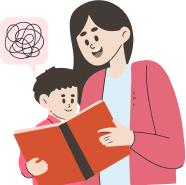You watch your child struggle with reading and wonder why it doesn’t come easily. Oftentimes, the answer lies in phonics vs phonology, which guide how children recognize sounds and words.
Understanding how each skill supports reading can make a real difference in your child’s confidence and progress. Knowing which skills to focus on and when can turn frustration into excitement for learning.
In this guide, you will discover the differences between phonological awareness and phonics, the key skills your child develops in each, practical ways to support them at home, common mistakes to avoid, and actionable tips to make reading fun and effective.
By the end, you’ll have a clear roadmap to help your child become a confident, independent reader.
Quick Overview
-
Phonological awareness focuses on hearing and manipulating sounds; phonics connects those sounds to letters.
-
Mastery of both skills creates a strong foundation for confident reading.
-
Children develop measurable milestones in sound recognition, decoding, and spelling.
-
Parents can reinforce learning through playful, structured home activities and routines.
-
Avoid common mistakes and follow simple, research-backed strategies to make reading engaging.
Why Phonics and Phonological Awareness Matter for Early Reading?

Your child's reading success depends on mastering these two fundamental skills before formal reading instruction begins. Research from the National Reading Panel shows that children with strong phonological awareness in preschool become more fluent readers by third grade.
The timing of these skills matters more than you might realize. Research shows that more than 70% of poor readers had a history of deficits in phonological awareness or oral language in kindergarten. Early identification and support are crucial, as these difficulties often persist without intervention, underscoring the powerful impact of your early involvement.
Think of these skills as the invisible foundation underneath a house. You may not see phonological awareness and phonics in action, but they support everything your child does with reading. Without this foundation, comprehension, vocabulary, and reading enjoyment all become much harder to develop.
Strong early reading skills start with recognizing and playing with sounds. Let’s explore what phonological awareness is and how it develops in your child.
Understanding Phonological Awareness
Phonological awareness comes from phonology, the study of language sounds, and refers to your child’s ability to notice, play with, and manipulate those sounds before learning to read. This sophisticated skill develops in your child's mind before they ever see a written word or know the names of letters.
Your child demonstrates early phonological awareness when they notice that "dog" and "log" sound similar. They might giggle at nonsense rhymes or try to create their own silly sound combinations. These playful moments show their brain are analyzing language patterns.
The development follows a predictable sequence that you can observe and support. Your child first notices big sound chunks like syllables in their own name. Then they recognize smaller patterns, such as rhyming endings. Finally, they can identify and manipulate individual sounds within words.
Advanced phonological awareness skills include:
-
Onset and rime manipulation - separating "cat" into /c/ and "at", then changing it to "bat"
-
Phoneme deletion - saying "sand" without the /s/ sound to make "and"
-
Phoneme substitution - changing the first sound in "run" to /s/ to make "sun"
-
Sound reversal - hearing "top" and saying "pot" by flipping the sounds
These advanced skills typically develop between ages 5 and 7 and predict strong reading abilities. Children who master phoneme manipulation often become the most confident decoders and spellers in their class.
Hearing and manipulating sounds lays the groundwork for reading, but connecting those sounds to letters is the next crucial step; this is where phonics comes in.
Understanding Phonics

Phonics teaches your child the relationship between letters and the sounds they represent. This is where written language comes into play. Your child learns that specific letters or groups of letters make predictable sounds.
Phonics instruction usually starts with simple letter-sound relationships. Your child learns that the letter 'b' makes the /b/ sound and the letter m makes the /m/ sound. These basic connections allow them to decode simple words.
The process becomes more complex as your child learns about letter combinations. They discover that 'ch' makes one sound, not two separate sounds. They also understand that some letters make different sounds in different words.
Phonics instruction typically follows this progression:
-
Letter recognition - identifying and naming letters
-
Letter-sound correspondence - connecting letters to their sounds
-
Blending sounds - combining letter sounds to read words
-
Decoding skills - using phonics rules to read unfamiliar words
-
Encoding skills - using sound-letter knowledge to spell words
Your child uses phonics every time they sound out a word while reading. They also use it when they try to spell words by thinking about what sounds they hear.
Also Read: Kindergarten Reading Level Guide and Tips
Now that you see how phonics works, you can better understand how it complements phonological awareness and how the two differ in practice.
Phonics vs Phonology: Key Differences
Phonology and phonics are distinct but equally important skills for learning to read. Understanding their differences helps you provide the proper support at the right time and build a strong reading foundation.
Here’s a clear comparison of phonology vs phonics to help you understand how each skill contributes to your child’s reading development.
|
Aspect |
Phonology |
Phonics |
|
Primary focus |
Understanding and recognizing the sound system of language |
Connecting sounds to written letters. |
|
Materials needed |
None - uses only spoken language. |
Books, letters, printed materials. |
|
Skills involved |
Listening, sound discrimination, sound patterns |
Visual recognition, sound-symbol connection, and decoding. |
|
Development timing |
Emerges naturally at ages 3-5. |
Requires formal instruction for ages 4-7. |
|
Example activity |
Clapping syllables in "butterfly". |
Sounding out the word "cat" from letters c-a-t. |
|
Learning method |
Through play, songs, and conversation. |
Through systematic teaching and practice. |
|
Success indicator |
The Child can hear and manipulate sounds in words |
The child can see letters c-a-t and read "cat". |
|
Assessment method |
Ask the child to perform sound tasks verbally. |
Watch a child read simple words or spell. |
|
Daily practice time |
5-10 minutes through natural play. |
10-15 minutes with focused activities. |
When you see your child struggling with reading, this table will help you identify which skill needs more support. If they cannot hear rhyming words, focus on phonological awareness first. If they listen to sounds but cannot connect them to letters, emphasize phonics practice.
What Skills Your Child Will Learn in Phonological Awareness and Phonics?

Your child will develop essential skills in hearing, manipulating, and connecting sounds to letters. Tracking these milestones helps you celebrate their progress and guide them toward confident, independent reading.
Phonological Awareness Skills
Your child's auditory processing abilities develop through distinct, measurable stages. These skills often emerge naturally through rich language experiences; however, you can accelerate their development through targeted play.
-
Rhyme mastery
It goes beyond simple recognition to creative generation. Your child progresses from completing familiar nursery rhymes to inventing completely new rhyming pairs. Advanced rhymers can produce multiple words that rhyme with any given word and understand that rhyming words often share spelling patterns.
-
Syllable manipulation
Syllable manipulation evolves from basic clapping to sophisticated word surgery. Your child learns to delete syllables ("Say rainbow without rain"), add syllables ("Add 'ing' to the end of jump"), and substitute syllables ("Change the 'mer' in summer to make winter").
-
Phonemic awareness
It represents the pinnacle of phonological development. Your child can isolate the middle sound in "ship" or explain why "scrap" has four letters but five sounds. This precision with individual phonemes directly predicts success in spelling and decoding.
-
Alliteration detection
Alliteration detection helps your child notice sound patterns across words. They spot repeated initial sounds in tongue twisters and can generate their own alliterative phrases. This skill strengthens phonemic awareness and supports later vocabulary development.
Phonics Skills
Your child's visual-auditory integration abilities determine how quickly they progress from a beginner reader to a fluent decoder. These skills require systematic instruction combined with extensive practice opportunities.
-
Grapheme recognition speed
It determines reading fluency more than any other single factor. Your child must instantly recognize letter shapes in various fonts, sizes, and contexts. Quick letter recognition allows mental energy to focus on meaning rather than decoding mechanics.
-
Morphological awareness
Morphological awareness helps your child understand how word parts carry meaning. They recognize that 'un' makes words mean the opposite and '-ed' signals past tense. This knowledge helps them decode longer, unfamiliar words and significantly improves their spelling.
-
Irregular word strategies
This skill will become crucial as your child encounters high-frequency words that break phonics rules. They develop visual memory techniques for words like "said," "was," and "come" while still applying phonics knowledge to regular words.
-
Contextual decoding
Contextual decoding skill will allow your child to use sentence meaning to support phonics knowledge. When they read "The dog wagged its tail," context helps them decode "wagged" even if they struggle with the double consonant pattern.
Also Read: Types of Reading Impairments and Solutions
Once you understand the skills your child is developing, the next step should be to learn how to nurture these abilities at home through engaging and effective activities.
How to Support Phonological Awareness and Phonics at Home?

Your home environment provides countless opportunities to strengthen both skill areas through activities that feel natural and enjoyable. The key lies in recognizing teaching moments and maximizing their impact without creating pressure.
Supporting Phonological Awareness
Transform everyday conversations into powerful learning experiences that develop your child's sound sensitivity and manipulation abilities.
-
Mealtime sound games turn family dinners into learning opportunities. Play "Rhyme Time" where everyone finds words that rhyme with the food on their plate. Create silly sentences using alliteration: "Sally's spaghetti slides slowly." These games feel like entertainment rather than instruction.
-
Bedtime sound stories help your child wind down while practicing phonological skills. Make up stories where characters' names all start with the same sound, or create adventures where rhyming words solve problems. Your child's giggles indicate both engagement and learning.
-
Movement-based activities combine physical energy with sound awareness. Have your child jump for each syllable in their full name, march to the rhythm of familiar songs, or dance to emphasize rhyming words in music. Physical movement strengthens memory for sound patterns.
-
Sound scavenger hunts during walks or car rides keep your child actively listening. Challenge them to find three things that start with /b/ or listen for words ending in the same sound. This heightened awareness transfers to formal reading activities.
Supporting Phonics
Create systematic opportunities for your child to connect their sound knowledge to written letters and words through structured yet playful activities.
-
Environmental print exploration shows your child that phonics knowledge applies to real-world reading. Point out letters in store signs, street names, and food packaging. Ask your child to find specific letters or sound out simple words they encounter naturally.
-
Letter-sound treasure boxes make abstract concepts concrete and memorable. Collect small objects that start with target sounds and store them in labeled containers. Your child can sort objects, match them to letters, and create stories using multiple items from the same sound box.
-
The decodable book graduation system provides appropriately challenging reading practice. Start with books containing only the letter-sounds your child knows, then gradually introduce new patterns. This systematic progression builds confidence and prevents frustration.
-
Family writing projects apply phonics skills to meaningful communication. Help your child write grocery lists, thank-you notes, or storybooks for younger siblings. Real-world writing purposes motivate children to use their phonics knowledge accurately.
Even well-intentioned parents sometimes create obstacles to their child's progress through common teaching mistakes.
Also Read: How to Improve Your Child’s Reading Skills
Common Mistakes to Avoid While Teaching

Understanding these common pitfalls helps you avoid inadvertently slowing your child's progress or creating negative associations with reading activities.
-
Mixing up skill domains during instruction can confuse your child and dilute the learning focus. When working on rhyming games, resist the urge to show letters or ask about spelling. Keep phonological awareness activities purely auditory and phonics activities visually focused.
-
Teaching letter names before letter sounds creates unnecessary confusion for beginning readers. Your child benefits more from knowing that 'm' says /mmm/ rather than learning its alphabetical name first. Letter names become essential later for spelling instruction and alphabetical order tasks.
-
Overwhelming your child with too many new patterns simultaneously creates cognitive overload and frustration. Introduce one new phonics pattern at a time and practice it extensively before adding another. Mastery of fewer patterns serves your child better than superficial exposure to many patterns.
-
Dismissing invented spelling as "wrong" discourages your child's natural development of phonics knowledge. When your child writes "luv" for "love," they demonstrate a sophisticated understanding of letter-sound relationships. Celebrate their phonetic logic while gently showing conventional spelling.
-
Forcing advanced skills before foundational ones can lead to struggle and confusion for your child. If your child cannot reliably identify rhyming words, they are not ready for complex phonemic manipulation tasks. Build each level thoroughly before advancing.
-
Creating high-pressure, formal lesson atmospheres transforms joyful learning into a stressful obligation. Your child learns best through playful interactions that feel like games rather than academic drills. Keep activities light, fun, and pressure-free.
Avoiding these mistakes while implementing proven strategies maximizes your child's growth and maintains their enthusiasm for reading.
Also Read: Understanding Text and Reading Strategies
Tips for Teaching Phonological Awareness and Phonics Successfully

These research-backed strategies help you create optimal learning conditions that accelerate your child's progress while maintaining their love for language and reading.
Tip 1: Match activities to your child’s energy and attention patterns
-
Observe when your child is most alert, such as after breakfast or before bedtime.
-
Schedule literacy activities during these peak times for better focus.
Tip 2: Use the "sandwich technique" to maintain motivation
-
Begin sessions with a familiar skill your child can do well.
-
Introduce one new challenge in the middle.
-
End with another successful activity to boost confidence.
Tip 3: Connect learning to your child’s interests
-
Use themes your child loves, like trucks or animals, in phonics and rhyming games.
-
Relating lessons to their world increases engagement and memory retention.
Tip 4: Establish consistent routines
-
Create predictable signals for learning time, like “sound game time” after dinner.
-
Routines make children feel secure and ready to participate.
Tip 5: Document progress to maintain motivation
-
Take photos, record sessions, or keep simple notes.
-
Reviewing progress builds confidence during slower learning periods.
Tip 6: Collaborate with your child’s teacher
-
Align home practice with classroom lessons.
-
Focus on phonics patterns or phonological skills currently being taught.
Tip 7: Use transition and waiting times for learning
-
Turn short moments, such as grocery checkout lines and car rides, into learning opportunities.
-
Practice rhyming, syllables, or sound games without extra scheduling stress.
By blending these strategies consistently, you strengthen your child’s phonological awareness, their practical understanding of language sounds, which draws on phonology and phonics skills, while keeping learning playful and motivating.
Wrapping Up
Understanding phonics vs phonology helps your child build strong reading skills and become a confident, independent reader. Phonological awareness sharpens their ability to hear and manipulate sounds, while phonics connects those sounds to letters and written words. Together, they create a strong foundation for fluent reading and a lifelong love of books.
Your child thrives when learning feels fun, engaging, and supported. Small-group interaction, personalized attention, and activities aligned with their interests make a real difference in building reading confidence.
To provide your child with the best support at home and ensure consistent, structured learning, platforms like FunFox offer expert guidance and interactive programs designed to promote real progress.
How FunFox supports your child’s reading journey:
-
Readers Club – Small-group online classes for grades 2–8 that strengthen reading skills and foster a love for books
-
Structured Learning – Lessons designed according to the Australian curriculum with interactive, playful methods
-
Ongoing Feedback – Teachers provide personalized guidance and monitor progress for continuous improvement
-
Engaging Environment – Our teachers make reading lessons interactive, enjoyable, and confidence-boosting
Give your child the confidence to read independently and enjoy every story. Book a free trial class with FunFox Readers Club and watch them unlock the joy of reading.
FAQ’s
1. What is phonology in literacy?
Phonology is the study of sounds in language. In literacy, it helps children recognize, distinguish, and manipulate spoken sounds, forming the auditory foundation needed for reading and spelling.
2. Which comes first, phonics or phonological awareness?
Phonological awareness comes first. Children develop the ability to hear and manipulate sounds before linking them to letters through phonics, ensuring stronger decoding and reading skills.
3. Are phonics and literacy the same thing?
No. Phonics is a specific skill for teaching the relationships between letters and sounds. Literacy is broader, encompassing reading, writing, comprehension, vocabulary, and the ability to communicate effectively through language.
4. What are the four types of phonics?
The four types are synthetic phonics, analytic phonics, embedded phonics, and analogy-based phonics. Each uses different methods to teach sound-letter connections for decoding and spelling.
5. What is the main purpose of phonology?
Phonology helps children understand sound patterns in language. It builds auditory awareness, supports decoding, and lays the foundation for accurate reading, spelling, and effective communication.















